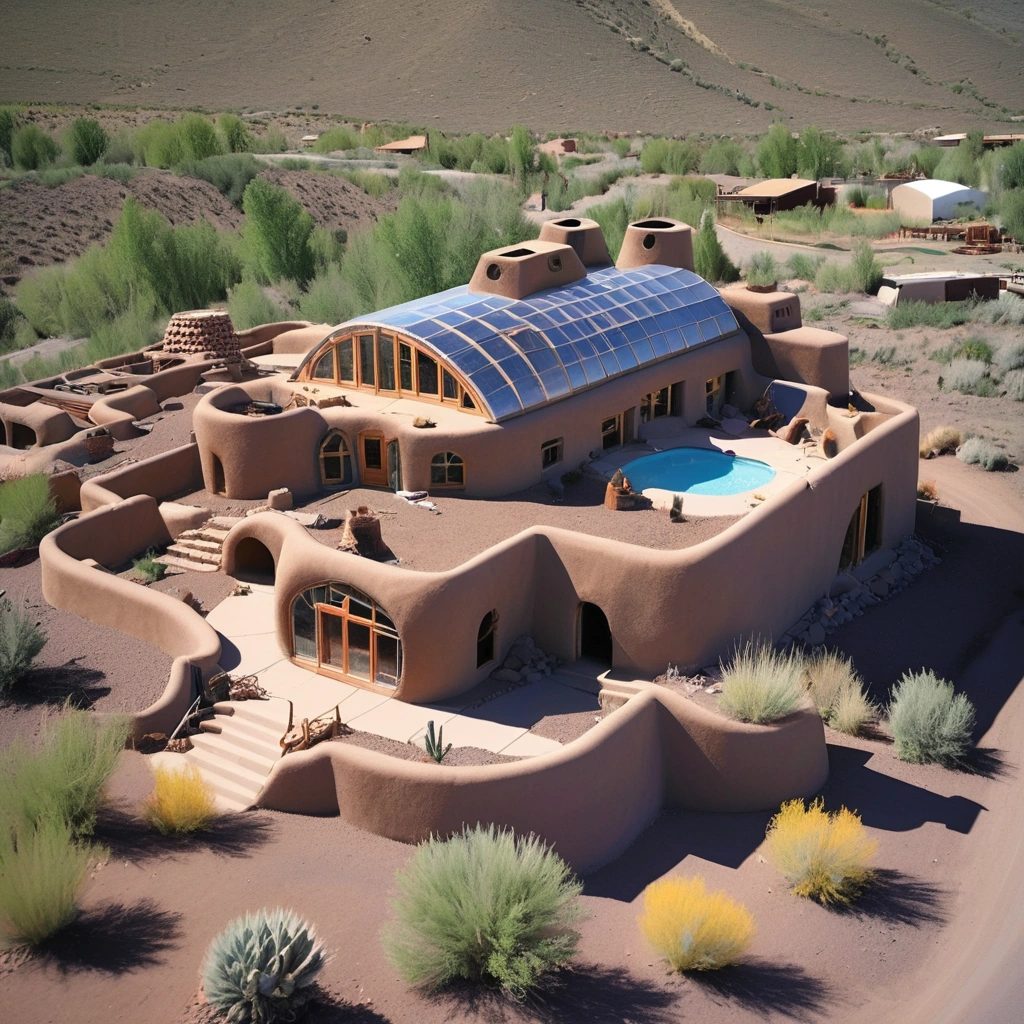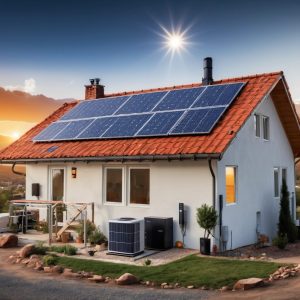Building a Resilient Desert Home: Advanced Earthship Construction in Taos Mesa
Introduction: The Promise and Challenge of Earthship Living in Taos
Taos Mesa, New Mexico – In the high-altitude desert of Taos, where the sun blazes and water is a precious commodity, a unique architectural movement has taken root: the Earthship. These radical, self-sufficient homes, constructed from recycled materials and designed to harness the power of nature, offer a compelling vision for sustainable living in arid environments. But building a resilient Taos Earthship in Taos Mesa presents unique challenges, demanding a deep understanding of local conditions, advanced desert construction techniques, and innovative resource management strategies.
This guide provides a comprehensive overview of the key considerations for aspiring Earthship builders, sustainable construction professionals, and anyone interested in off-grid living in this remarkable landscape. The allure of self-sufficiency and harmony with nature draws many to consider Earthship construction. However, the reality requires careful planning, technical expertise, and a commitment to sustainable practices. This article, drawing on expert viewpoints and practical case studies, aims to equip readers with the knowledge to navigate the complexities of building a thriving Earthship in Taos Mesa.
The sustainable southwest presents a compelling case for alternative building methods, especially as climate change intensifies. Unlike conventional adobe building, which often relies on resource-intensive processes for material acquisition and energy for climate control, Earthships strive for complete autonomy. Passive solar design is paramount, with south-facing glazing capturing solar energy for heating, while thermal mass, primarily in the form of earth-bermed tires, regulates temperature fluctuations. Rainwater harvesting systems provide potable water, and greywater recycling minimizes water waste, crucial for off-grid living in an arid environment.
The integration of these systems marks a significant departure from traditional New Mexico architecture, offering a pathway toward truly sustainable habitation. Modern Earthship construction in 2025 is seeing a surge in technological advancements that further enhance their efficiency and resilience. Smart home technology is being integrated to optimize energy consumption, monitor water levels, and automate environmental controls. For instance, advanced sensors can track temperature and humidity levels within the thermal mass, adjusting ventilation and shading systems to maintain optimal comfort.
Furthermore, innovations in solar panel technology are increasing energy production, while improved battery storage solutions ensure a reliable power supply, even during extended periods of cloud cover. These technological integrations are making Earthships even more viable and attractive as a model for sustainable living. However, the path to Earthship construction is not without its hurdles. Navigating local building codes and obtaining the necessary permits can be a complex and time-consuming process, particularly in areas with established architectural norms. Furthermore, the upfront investment in specialized equipment and skilled labor can be substantial. Despite these challenges, the long-term benefits of Earthship living, including reduced utility bills, environmental responsibility, and increased self-sufficiency, make it an increasingly appealing option for those seeking a more sustainable and resilient lifestyle. The growing interest in Earthships reflects a broader shift towards environmentally conscious living and a desire to reduce our impact on the planet.
Site Selection and Permitting on Taos Mesa: Navigating Regulations and Terrain
Selecting the right site is paramount for Taos Earthship success, a principle deeply embedded in the ethos of sustainable southwest design. Taos Mesa, with its dramatic topography, presents unique challenges, including varying soil compositions, drainage patterns crucial for rainwater harvesting, and optimal solar access for passive solar design. Prospective builders must move beyond intuition and conduct thorough site assessments, including geotechnical soil testing to determine load-bearing capacity and percolation rates, topographical surveys to map drainage and solar angles, and microclimate analysis to understand wind patterns and temperature variations.
These assessments inform crucial decisions about foundation design, water management strategies, and the orientation of the Earthship to maximize thermal mass efficiency. Neglecting these steps can lead to structural instability, inadequate water supply, or ineffective temperature regulation, undermining the core principles of off-grid living. Permitting in Taos County, while supportive of innovative New Mexico architecture like Earthships, demands meticulous adherence to local zoning regulations and building codes. According to the Taos County Planning Department’s 2024 guidelines, Earthship construction must meet stringent requirements related to water harvesting capacity (minimum 15,000-gallon storage), greywater recycling systems (NSF 350 certification required), and structural integrity verified by a licensed engineer specializing in desert construction.
A representative from the department emphasized, “We champion sustainable building practices, but all projects must demonstrate a commitment to environmental stewardship and public safety through rigorous engineering and compliance with established codes.” Understanding these regulations and proactively engaging with local authorities early in the planning process is not merely advisable; it is essential to avoid costly delays, potential redesigns, and ensure project approval. Beyond the basic requirements, successful Taos Earthship projects often incorporate advanced site-specific strategies.
Consider the integration of swales and berms to enhance rainwater harvesting and prevent erosion, especially on sloping sites. Detailed hydrological studies can predict runoff patterns and inform the design of efficient water collection systems. Furthermore, understanding subsurface geology can reveal opportunities for geothermal heating and cooling, further reducing reliance on external energy sources. By viewing the site as an integrated ecosystem, builders can optimize resource utilization and create a truly resilient and sustainable desert home. Navigating these complexities requires a collaborative approach, engaging with local experts in hydrology, geotechnical engineering, and sustainable building practices to ensure that the Earthship harmonizes with its environment and meets the highest standards of environmental responsibility.
Adobe vs. Earthship: Comparing Traditional and Modern Sustainable Building
Adobe, a traditional building material deeply rooted in the Southwest, offers inherent thermal mass and a timeless aesthetic appeal, defining much of New Mexico architecture for centuries. However, Earthship construction, a more recent innovation, diverges significantly from traditional adobe techniques by boldly incorporating recycled materials like discarded tires and aluminum cans, coupled with a comprehensive focus on complete self-sufficiency. While adobe structures excel at moderating daily temperature swings due to their thermal properties, they often necessitate considerable energy input for supplemental heating and cooling, particularly in the extreme climates of the sustainable southwest, and typically rely on external, municipal water sources.
This dependence contrasts sharply with the Earthship ethos of radical independence. Earthships, conversely, are meticulously designed to be passively heated and cooled through strategic thermal mass integration, precise solar orientation, and carefully engineered natural ventilation systems. These design elements are crucial for successful desert construction. Furthermore, Earthships prioritize on-site rainwater harvesting and greywater recycling systems to drastically minimize reliance on external water resources, addressing a critical need in arid regions like Taos. The benefits of Earthship design are manifold: a substantially reduced reliance on fossil fuels for heating and cooling, minimized water consumption through closed-loop systems, waste reduction achieved through the resourceful use of recycled materials, and an amplified sense of self-sufficiency, empowering residents to live more sustainably.
However, the path to Earthship living is not without its challenges. Drawbacks can include higher initial construction costs compared to conventional building methods, stemming from the labor-intensive nature of tire packing and specialized system installation. The complex construction techniques involved often require specialized knowledge and a willingness to learn unconventional building practices. Moreover, navigating the permitting process can be particularly challenging, especially in regions where building codes are not yet fully adapted to accommodate the use of recycled materials and innovative off-grid technologies.
Overcoming these hurdles often necessitates proactive engagement with local authorities and a commitment to educating them about the sustainable principles underlying Earthship design. One key difference lies in the embodied energy of the materials. Adobe, while natural, often requires significant energy for processing and transportation. Earthships, by utilizing locally sourced recycled materials, drastically reduce this embodied energy. A Taos Earthship case study, documented by the Earthship Biotecture Academy, demonstrated a 70% reduction in embodied energy compared to a similarly sized conventional home. Furthermore, the integration of advanced rainwater harvesting systems, often incorporating multi-stage filtration and UV sterilization, ensures a potable water supply even during prolonged droughts, a critical advantage for off-grid living in the arid southwest. This holistic approach, combining resourcefulness with technological innovation, positions the Earthship as a compelling model for sustainable desert construction in the 21st century.
Thermal Mass Integration: Optimizing Temperature Regulation in Extreme Climates
Thermal mass is the cornerstone of Earthship temperature regulation. In the extreme desert climate of Taos, where temperatures can fluctuate dramatically between day and night, effectively integrating thermal mass is critical. Earthships utilize dense materials like earth-filled tires, adobe, and rammed earth to absorb and store heat during the day, releasing it slowly at night. The strategic placement of these materials, coupled with proper insulation and ventilation, creates a stable and comfortable indoor environment. Material selection is crucial.
Earth-filled tires, while providing excellent thermal mass, require careful construction and compaction. Adobe offers a more traditional aesthetic but may require additional insulation in colder climates. Rammed earth provides a durable and sustainable option but can be labor-intensive. Construction methods must also be carefully considered to ensure optimal thermal performance. This includes proper compaction of earth materials, strategic placement of windows for solar gain, and effective insulation to minimize heat loss. According to a study by the New Mexico Solar Energy Association, well-designed Earthships can maintain a stable indoor temperature of 60-75°F year-round with minimal or no auxiliary heating or cooling.
Beyond material selection and construction techniques, the integration of passive solar design principles is paramount for maximizing the effectiveness of thermal mass in a Taos Earthship. Orienting the building along an east-west axis, with the majority of glazing facing south, allows for optimal solar gain during the winter months. Overhangs and shading devices are then strategically employed to prevent overheating during the summer. This careful balance of solar gain and shading, combined with the inherent thermal properties of the building materials, creates a remarkably stable and comfortable indoor environment, reducing the reliance on external energy sources and contributing to the overall goals of off-grid living and sustainable southwest architecture.
The success of thermal mass integration also hinges on understanding the specific microclimate of the building site. Variations in elevation, exposure to wind, and proximity to vegetation can all influence temperature fluctuations. Advanced modeling software can be used to simulate the thermal performance of different design options, allowing builders to optimize the placement of thermal mass and glazing for maximum efficiency. Furthermore, the integration of rainwater harvesting systems can contribute to thermal stability by providing a source of evaporative cooling during the summer months.
By carefully considering these factors, builders can create a Taos Earthship that is not only aesthetically pleasing but also highly resilient to the challenges of the desert construction environment. Looking ahead to Modern Earthship Construction Guide 2025, innovations in materials science and building automation promise to further enhance the performance of thermal mass systems. Phase-change materials (PCMs), which absorb and release heat as they change state, can be integrated into walls and floors to increase thermal storage capacity. Smart home technologies can also be used to optimize ventilation and shading based on real-time weather conditions, further reducing energy consumption. As the demand for sustainable building solutions continues to grow, these advancements will play an increasingly important role in shaping the future of New Mexico architecture and off-grid living.
High-Altitude Solar Energy Optimization: Harnessing the Sun’s Power
Taos Mesa’s high altitude and abundant sunshine create an exceptional environment for solar energy generation, a cornerstone of off-grid living and Taos Earthship design. Optimizing solar energy systems, however, demands meticulous planning, considering panel orientation, shading patterns influenced by the dramatic desert landscape, and the stark seasonal variations in sunlight. Photovoltaic (PV) systems are essential for powering lighting, appliances, and various household needs within these self-sufficient structures. System design must precisely match energy consumption patterns, incorporating sufficient battery storage capacity to guarantee a reliable power supply, particularly during extended periods of cloud cover or shorter winter days.
Modern Earthship Construction Guide 2025 emphasizes the use of smart inverters and energy management systems to maximize efficiency and prolong battery lifespan, crucial for the long-term sustainability of these desert constructions. Passive solar design techniques further enhance energy efficiency and reduce reliance on external sources. South-facing windows, strategically sized and positioned, capture solar heat during the day, while Trombe walls, a signature element in many Earthships, play a crucial role in thermal mass integration. These walls, constructed of dark-colored, high-density materials like adobe building blocks or rammed earth, absorb solar radiation and gradually release heat into the interior spaces during the cooler evening and nighttime hours.
This natural heating process minimizes the need for supplemental heating, contributing to the overall energy independence of the structure. According to a study by the New Mexico Solar Energy Association, effective passive solar design can reduce heating costs by up to 75% in the sustainable southwest. To maximize solar gain at high altitude, several key strategies are essential. First, optimizing the panel tilt angle to capture the lower winter sun is critical. A steeper angle allows for greater energy capture during the months when sunlight is most scarce.
Second, minimizing shading from trees, neighboring structures, or even the Earthship’s own design elements is crucial. Regular trimming of vegetation and careful consideration of building placement can significantly improve solar energy production. Third, investing in high-efficiency PV panels, which convert a greater percentage of sunlight into electricity, is a worthwhile investment, especially in a location with limited sunlight hours. Finally, implementing a smart energy management system that monitors energy production and consumption, and automatically adjusts loads to optimize efficiency, is essential for ensuring a reliable and sustainable off-grid living experience in these unique New Mexico architecture examples. These systems often incorporate features like remote monitoring and control, allowing residents to fine-tune their energy usage and maximize the benefits of their solar investment.
Native Water Management Systems: Harvesting, Recycling, and Conserving
Water is a precious resource in the desert, and Earthships, particularly in arid regions like the sustainable southwest, are designed to minimize consumption and maximize harvesting. Rainwater harvesting forms the cornerstone of their water strategy, with collection surfaces meticulously integrated into the passive solar design of the structure. Water is channeled from the roof into large-capacity cisterns, often buried to maintain a cool temperature and prevent evaporation. The size of these cisterns is carefully calculated based on local rainfall data and anticipated water usage, ensuring a reliable supply even during prolonged dry periods, a critical consideration for off-grid living.
The New Mexico Office of the State Engineer provides crucial guidelines and regulations for these systems, ensuring responsible and sustainable implementation. Greywater recycling systems represent another vital component of water management in a Taos Earthship. Wastewater from showers, sinks, and washing machines undergoes a multi-stage filtration process, typically involving settling tanks, sand filters, and plant-based biofilters. This treated greywater is then reused for non-potable purposes such as irrigation and toilet flushing, significantly reducing the demand for fresh water.
The choice of plants in the biofilter is crucial; native, drought-tolerant species not only thrive in the arid climate but also play a role in purifying the water. These systems are particularly relevant to New Mexico architecture, where water conservation is paramount. Beyond harvesting and recycling, water conservation strategies are integral to the overall design. Low-flow fixtures, such as toilets and showerheads, minimize water usage without compromising performance. Drought-tolerant landscaping, featuring native plants adapted to the desert environment, further reduces the need for irrigation.
These plants, often sourced locally, not only conserve water but also provide habitat for native wildlife, contributing to the ecological sustainability of the site. The integration of these strategies, combined with effective rainwater harvesting and greywater recycling, allows Earthships to achieve a remarkable degree of water self-sufficiency, a key element of desert construction and a hallmark of the Taos Earthship philosophy. Advanced strategies for water management in modern Earthship construction extend beyond simple collection and reuse.
Atmospheric water generators, while energy-intensive, can provide a supplementary source of potable water in extremely arid conditions. Furthermore, innovative research is exploring the use of constructed wetlands for enhanced greywater treatment, mimicking natural ecosystems to purify water more effectively. These advanced systems, coupled with traditional methods, represent the future of sustainable water management in the southwest, ensuring the long-term viability of off-grid communities and promoting responsible resource utilization in the face of increasing water scarcity. Integrating these systems with the thermal mass of an adobe building can also help regulate water temperature, further optimizing resource use.


